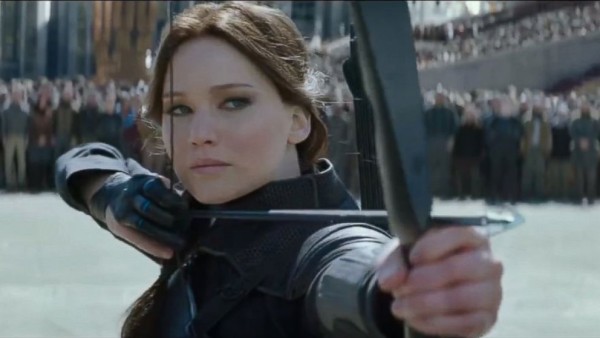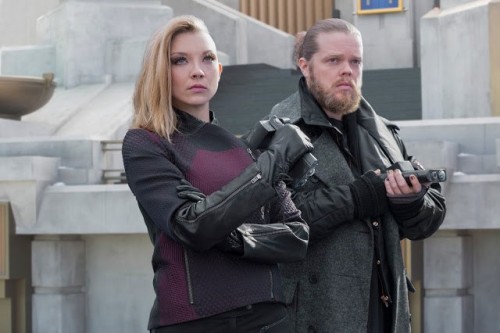Box office numbers are coming in for the past weekend, which saw the wide release of The Hunger Games: Mockingjay Pt. 2, the fourth and final installment of The Hunger Games film franchise. They’re typically ginormous – buoyed by hordes of fans who poured out for the latest event movie of the season (see Bond, James and that upcoming space opera movie for other similar event movies).
And yet, there’s already a sense of disappointment going around the Internet at the cumulative take.
The title of the weekend summary at BoxOfficeMojo.com reads “Mockingjay Part 2 Creeps Over $100 Million“. For any other movie (except for maybe that aforementioned sci-fi flick, any major Marvel movie, and Jurassic World), a hundred freaking million dollars would seem to be a major deal. Think of what would happen if something more innocuous like The Peanuts Movie or another flamboyant blockbuster like Mission Impossible would garner – it would be surprise, if not shock and awe.
And yet, we live in a world where massive amounts of dollars get thrown around with a sense of historical perspective, and the past cannot be discounted here – this is the lowest opening weekend take for any of the four movies in the series. Respectively, Hunger Games earned $151 million in spite of casting an unknown (at the time) lead in a female-centric franchise. Catching Fire, regarded as the best in the series, topped that with $158 million. Everything was coming up Katniss, it seemed.
And then things went down. Mockingjay Pt. 1 opened to the tune of $121 million, still impressive, if not a noticeable sign of what to expect for the second release. This weekend, the reins have been slipped, letting loose the Mutts of war – in this case, Internet hyper-trolls referencing the utter disappointment of the film.
And that’s a shame, because the last two movies of the franchise have been some of the better and more thought-provoking blockbusters to be released. As with many other major event films, they’re bloated and suffer from taking a long time to say what they’re trying to say, but they’re reasonably well crafted with a distinct aesthetic, quality performances, and visceral action sequences.
So what happened?
The Film’s a Bore…
(SPOILER ALERT: don’t read this section if you don’t want the ending ruined for you. Then again, the book has been out for five or so years now, so if you’re reading this and haven’t either read this or seen the movie, then you really don’t care anyway. So make your own choices.)
The Hunger Games and Catching Fire both benefited from the titular events of the franchise – the Battle Royale cum Survivor cum Dawson’s Creek free for all in which Katniss Everdeen (Jennifer Lawrence) fights for her life in a post-apocalyptic world against children ranging in age from 11 to 17. In the Mockingjay films, that spectacle is traded in for an underground (literally) rebellion against the Capital and the evil President Snow (Donald Sutherland). Katniss is reduced to a sideline spectator, a morale-boosting figurehead stuck filming “propos” in an attempt to take down the enemy from within.
There’s a noticeable dearth of action in much of the second two films – both parts of the same book by Suzanne Collins – as Katniss and Co. are pushed to the sidelines. Off-screen bombs and exposition provided by Woody Harrelson’s increasingly two-dimensional Haymitch Abernathy fill up most of the running time. The second film does add in several set pieces – most notably a terrifying fight in the tunnels of the Capital – but those don’t make up for the growing sense that Katniss doesn’t have a whole lot to do.
That seems to be by design. In the first two films, the action takes place in the arena where Katniss, Peeta, and others must fight to survive, but much of the real story (the overthrow of the Capital) is happening behind the scenes. Katniss is a pawn in the larger scheme – a wildly effective pawn, but a pawn nonetheless. It’s in the third and fourth film where her lack of agency is revealed slowly and surely. Her speeches are scripted, she’s withdrawn from major combat, and trapped underground or on proxy missions to create propaganda. The majority of the last half of the film involves a desperate scramble towards the Capital’s center to assassinate President Snow, and (SPOILER ALERT) it’s no surprise when the entire mission proves to be futile – the war is over by the time they make it through.
That’s why the biggest moment comes during the execution of Snow when Katniss elects (on her own and unprompted) to instead assassinate the increasingly dictatorial Interim President Coin (Julianne Moore, wearing what might be the greatest wig travesty on screen this year. Seriously, it’s like George Clooney did it with a mop.). Nobody working behind the scenes expects this choice. It’s entirely unorchestrated, unforeseen by every other character in the film. Katniss has emerged from her role as a pawn and seized control of her own future and the entire future of Panem.
It only took four movies for her to make a choice that deliberately affected the outcome of the story, four movies that mix great performances from the likes of Lawrence, Sutherland, Josh Hutcherson, and Elizabeth Banks in with typically bland performances from brooding blonde and brunette hunks (Liam Hemsworth and Sam Claflin) or over-emotive wannabe-Imperator Furiosas (Jena Malone is definitely no Charlize Theron). Robert Pattinson, we hardly knew ya.
So yeah, it might make sense that people got tired of watching things happen to Katniss Everdeen. Who wouldn’t get bored by that?
The Spectacle of Death
There’s another reason that might be a cause for the lower box-office performance of the penultimate and ultimate entries in the franchise, one that goes beyond franchise fatigue and deep into the meta-narrative of the Hunger Games themselves.
The first two movies are semi-satirical pieces that reflect upon the 24-hour narrative cycle of reality TV. We see Katniss and Peeta papered and paraded around on live television in the Capital, broadcast on all channels throughout Panem. The Games themselves are riveting spectacle, designed to maximize entertainment value not just by the characters but by the filmmakers themselves. When the citizens of Panem react to Katniss’s heroics, cinema-goers react with equal verve. When they cheer for the death of children, we cheer. When they cry, we cry.
The third and fourth movie go far deeper into discussions of PTSD and the consequences of the Games on their participants, but they also delve deeply into the machinations of propaganda and of the spectacle themselves. We get a hint as to how the Games themselves might come about when Coin presents a future where a new Games might be needed to quell dissent. Everywhere that Katniss goes, she is followed by a documentary crew. Her actions and reactions are filmed both by the Rebellion and by the Capital. That’s why I found her final gesture of action to be so thrilling…and that might be what she intended to have happen. We are all watchers of the Hunger Games.
But that’s boring – the lack of action presents the major flaw in the narratives of the last two movies. Without the Games themselves to serve as setpieces, we have no vested interest. That’s in part a flaw of the film making (wooden performances + overt exposition – action = snooze fest) but not entirely – they’re still good enough blockbusters that astute viewers should remain awake. The larger fault might lie in the fact that we’re not really watching The Hunger Games…we’re watching the actual Games themselves. Without our gladiator spectacles, we have nothing left to cheer for. Bread and circuses indeed.
In conclusion, the Hunger Games series will undoubtedly go down as a major success. It’s turned LionsGate into a top tier studio, and helped to build the empire of J-Law. And yet, there’s a sense that the larger part of the audiences that turned out in such droves for the films might have missed the larger point. These films are manufactured for our entertainment, much the same as the titular Games are manufactured for entertainment (and control of the populace, political manipulation, etc).
Katniss has ridden off into the sunset, taking with her the sadistic lure of the Games. The question posed by many reviewers after the arrival of the first film was ‘Who would watch such terrible events where children slaughter children?’
The answer, it turns out, is us.










